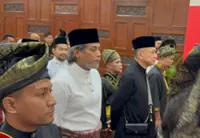HER steady fingers deftly weave a threaded needle on the collar of a green cotton baju Melayu.
The thread is wound in a braid underneath the cloth, but the outer stitchings now resemble an eel’s spine or “tulang belut”.
Follow us on our official WhatsApp channel for breaking news alerts and key updates!
Thank you for your report!





